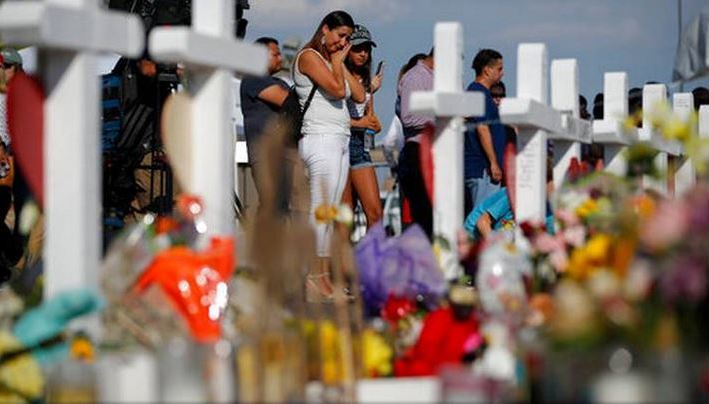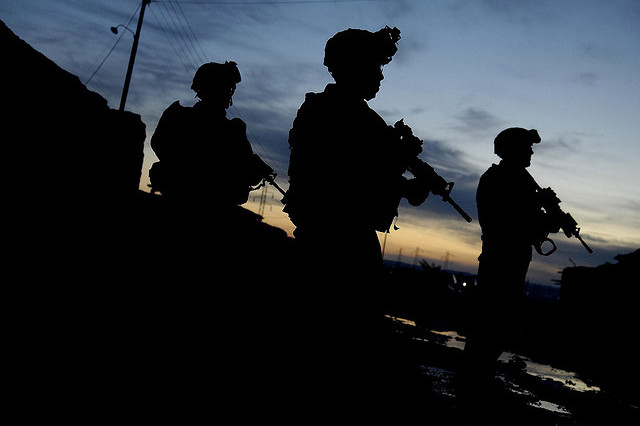by Emile Nakhleh
The recent mass murder at Walmart in El Paso was an act of terrorism, not much different from similar international terrorist attacks. Terrorizing innocent civilians, whether domestically or internationally, and spreading fear among the populace for whatever warped ideology or justification is part and parcel of the classical definition of terrorism.
International and domestic terrorist groups, cells, and individuals usually commit acts of terror in the name of specific religious, racial, ethnic, and other social ideologies. Ignorance and fear drive their view of the “other” and their desire to kill. Internationally, the “other” might be Muslims, Jews, Christians, Hindus, Kurds, Hutus, or Tutsis. Domestically, the “other” has included African Americans, Native Americans, Latinos, Muslims, Jews, Germans, and Japanese.
Three important factors are driving domestic terrorism: the pervasive use of the dark side of social media; the ubiquitous presence of deadly weapons; and the changing demography of the nation, which projects that within one to two generations a majority of Americans will be people of color. The “whiteness” of the minority is dimming, and the “brownness” of the majority is shining brighter. Because of these factors, which are not expected to recede anytime soon, domestic terrorism is expected to rise exponentially over the next decade.
Those who resent this demographic inevitability are burrowing deeper and deeper in the dark side of social media in search of empowerment, purpose, identity, and belonging. When a disgruntled, alienated, and angry young man joins a domestic terrorist group and begins to read its abhorrent literature and so-called manifestos, he expresses his commitment and fealty to these intolerant, exclusivist ideologies by committing violence against members of an “other,” perceived by the group as an existential threat.
Unlike terrorist recruitment and indoctrination a decade or two ago, today’s aspiring terrorists go online and read about hating other communities perceived by these radicalizers as non-white and non-Christian. Mental health and other explanations are for the most part simplistic and unproductive in understanding the nature of terrorism, domestically or internationally.
Leaders’ words and rhetoric matter in the indirect empowerment and recruitment of potential terrorists. I have studied Osama bin Laden’s public statements, messages, and pronouncements over the years. In every message, whether on Al Jazeera or online, Bin Laden had something to say to his followers and indicated a program of action against his perceived enemies.
He frequently repeated certain words and phrases as an effective tool to communicate his message to the “believers.” Examples included “crusaders,” “infidels,” “invasion,” and “anti-Islamic wars.” Similarly, such words as “invasion” figure prominently in the “manifestos” of some hate groups, as the El Paso massacre showed. Bin Laden’s targets were Christian “Crusaders,” Jews, Shia, the U.S., and Israel. The targets of domestic terrorists are for the most part non-white groups—African Americans, Sikh, Muslims, Latinos, LGBT, children, students, and the “invaders” from Mexico and Latin America.
Two Sides of the Same Coin
A decade or so ago, potential recruits and so-called lone wolves within the United States were usually radicalized and recruited by a human extremist. A Sunni Muslim young man, for example, who graduated from high school in Saudi Arabia, Bahrain, or some other country, might find himself unable to find a job, unable to get married, and forced to live at home. He might start going to the nearest mosque, get acquainted with a “jihadi” cleric, and embark on a process of radicalization and the urgent need to do “jihad” against the perceived enemies of Islam.
Defending Islam as a faith and a territory would become the overwhelming goal of such a young man. Jihad in this case often is expressed through violence against groups, countries, and individuals. If such a radicalized recruit were working with al-Qaeda or the Islamic State, he would be taught to adhere to the message of the group’s leader—Osama bin Laden in the case of al-Qaeda and the Islamic State’s Abu Bakr al-Baghdadi. The simple message from these leaders, which recruits came to know by rote, is simple: Since Islam is under attack by “Christian Crusaders and Zionists,” “jihad” becomes a required duty on Muslims to repel such attack.
In the case of the Islamic state, al-Baghdadi urged his followers to leave their countries and move to his self-designated Islamic caliphate. Life in the caliphate would allow them to live among other Muslims—people who hold similar beliefs, adhere to the same principles, speak the same “sacred language” of the Koran—safe from “invasion,” secure in their jobs, and unconcerned about being “displaced.” In this idyllic state, the inhabitants share sameness in culture, heritage, religion, and global vision.
Today—in part because of the pervasive use of social media—the situation is different: potential terrorists often become militants on their own. Domestically, potential terrorists are encounter radical ideologies online by burrowing into the dark side of the Internet and social media platforms and reading whatever tracts and manifestoes they can access. Here again the message is simple: the potential recruits are indoctrinated into believing that their culture, race, and heritage are being threatened by “foreign invaders” and dangerous “immigrants” (mostly Mexicans and Latinos). They are told that their jobs will disappear because of the hordes of immigrants. These recruits often do not differentiate between legal and illegal immigrants.
They are never told by their recruiters on the dark side that climate change, technology, and robotics, not immigrants, are the real culprits for job displacement. Nor are they told that the global economy often determines where jobs are located. Political leaders’ promises about bringing jobs back to the country are too simplistic and rarely materialize. Consequently, recruits and potential domestic terrorists focus their anger on a specific group of people, view them as the source of threat, and begin to plot violent acts against them—in schools, shopping malls, department stores, movie theaters, and churches. As domestic terrorist groups and individuals see their “sameness” eroding, they begin to justify their violence against other groups and the “diversity” they represent.
The Path Forward
America’s national security and value system are grounded in diversity—cultural, racial, ethnic, religious, linguistic. This amalgam of global cultures since 1776 has made America great for all Americans. When communities embrace and celebrate diversity, the voices of hate and division are drowned out.
At least three paths should be pursued at the national level. The president should reach out to the leaders of the House and Senate and ask them to join him in a nationally televised address to the nation, calling on all Americans to denounce racism, division, and hate. They must also tell hate groups and their recruits and adherents that they will be prosecuted as terrorists under the terrorism laws that were enacted before and since the heinous acts of 9/11.
Second, the Department of Justice, including the FBI, and the Department of Homeland Security should establish a joint task force to track domestic terrorism, report on it, and advise policymakers on on-going activities and gathering threats of terrorist groups and individuals. The expertise that the National Counterterrorism Center has accumulated in tracking international terrorists should be utilized in the fight against domestic terrorism. The two departments should begin to issue annual domestic terrorism threat reports, similar to the Director of National Intelligence’s annual report on international terrorism.
Third, the United States Congress should work to enact appropriate legislation to counter potential domestic terrorist groups and individuals. Terrorist recruiters, whether individuals or social media platforms, should be held responsible and prosecuted where appropriate.
The scourge of international terrorism has shaken the world for decades. It should not be allowed to metastasize domestically.






Emil Nakhle
60 years ago, many a 10-year old boy in America would wake up one Christmas morning to find a small caliber rifle under the tree. He would be instructed by his father and would use it to shoot squirrels etc. in the back yard and in the woods.
Crucially, he knew the difference between Right and Wrong.
That is lost now and needs to be restored. Executive or Legislative actions are useless, in my opinion.
Ascribing such horrors as keep happening to ‘terrorism’ is completely to miss the point. Motivation really is irrelevant; the particular form of delusion doesn’t matter to the dead or injured, or their families.
The difficulty is essentially open access to contemporary battlefield weapons, by untrained, unsupervised civilians. And by ‘training’ I mean a few years spent in the military. Not Uncle Sam’s Gun Book for Boys.
Until the problem of access to weapons – and of course ammunition – is corralled, the killing and bleeding will continue. As nothing will be done, arm yourself with a few boxes of Kleenex for the next few national boo-hoo moments.
it’d be interesting to know what fraction of the families of those slaughtered, themselves had guns at home. Physician, heal thyself.
Personally, I’ll continue to laugh sardonically at every mass killing, absent any serious attempt to ban the sale of assault weapons and their ammunition.
It sounds to me like the author wants violent insurrection. He speaks of the “other” and then goes on to state that anyone with a different ideology than his own should be labeled a terrorist. If you want a bloody war where millions of Americans die, keep promoting this idea.
Succinctly presented but (1.) overstates (or gives a wrong impression, unintentionally I’m sure) the actual numbers of people with truly violent tendencies. The author knows well that the percentages of extremists are small but rightly points out that the psychological ingredients for those numbers increasing are there as a potential. It’s important to bear in mind too that while whites won’t be the majority in a few generations they will still be the plurality population. (2.) The argument does not appreciate the social aspects of the urban/rural divide in this equation of threat and status perception. A perception by rural people – especially whites in particular – that they are under-represented in institutions of influence and import is met by an equal and corresponding perception of urban residents that the opposite is true. Consider the Pew numbers on perceived populations of LGBT, Hispanics, African Americans v. the self-reported (in surveys available at Pew’s website) numbers and figures from the American Community Survey (available at ACS website and discussed by Pew in their analysis). The perceived percentages are much higher in all cases and the minority groups themselves have the highest gap between perception of their size and reality.This has two consequences: the majority whites perception of being rapidly outnumbered is amplified while the perception of minority populations that they are discriminated against is similarly telescoped. This leads to vitriolic rhetoric and unwillingness to dialogue on both sides. This is in part a media mediated issue. Major media are centered in urban areas with a demographic profile at variance with the country as a whole. When media (and accepting the caveat that this is not a homogeneous group but the SES demographics are consistent across all types) present these issues they represent their own self-perception (including the above exaggerated sense of their own numbers) to the country rather than referring back to the entire population data. They fail to engage in self-weighting of their perspective to reflect the actual population. We are all fairly poor Bayesians in practice and tend to reify our own perspective as reflecting the whole.
As President Eisenhower predicted it and forewarned the American people about 7 decades ago, the military industrial complex (MIC) has taken control of the foreign and domestic policies in this country. The MIC continues to siphon closed to 50% of the pentagon’s budget (around $400B) and keeps marketing arms which can kill a whole bunch in few seconds easily into American military and Civilians to either kill a bunch of people domestically by civilians or in other places by the military. This has become a love affair between the people and the arm merchants and it could become a path to self destruction if the people don’t confront the problem now.
At the same time the MIC is laughing all the way to the bank!